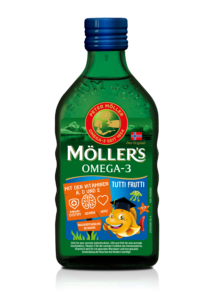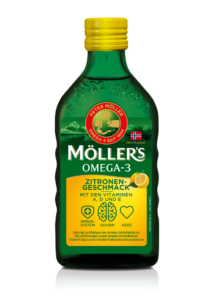
Vitamin D im Winter – Wie Möller’s Omega-3 wertvolle Unterstützung bietet
Im Sommer kann unser Körper bei genügend Sonnenlicht Vitamin D größtenteils selbst bilden. In den Wintermonaten jedoch reicht das Sonnenlicht in Mitteleuropa häufig nicht aus, um genug Vitamin D zu produzieren. Die körpereigenen Reserven werden allmählich aufgebraucht, was langfristig Folgen für Knochen, Muskeln und das Immunsystem haben kann – besonders bei einer Ernährung mit wenig vitaminreichen Lebensmittel.
Wirkung, Einnahme und Überdosierung von Vitamin D
Vitamin D ist ein essenzielles Vitamin, das zahlreiche zentrale Körperfunktionen beeinflusst:
- Es trägt zur normalen Funktion des Immunsystems bei.
- Es unterstützt die Erhaltung normaler Knochen und Muskeln.
- Es ist wichtig für die Aufnahme und Verwertung von Calcium und Phosphor.
Die Einnahme sollte gemäß Empfehlung erfolgen. Für Erwachsene und Kinder
ab 3 Jahren gelten in Deutschland 10 µg (400 IE) Vitamin D täglich als Richtwert – dies entspricht z. B. der Tagesmenge in 5 ml Möller’s Omega-3.
Eine gezielte Überdosierung, etwa durch hochdosierte Präparate ohne ärztliche Rücksprache, kann zu erheblichen Nebenwirkungen führen und ist deshalb zu vermeiden. Bevölkerungsgruppen mit einem generell erhöhten Vitamin-D-Bedarf wie z.B. ältere Menschen, vegan/vegetarisch lebende Personen, Menschen mit dunkler Haut oder chronischen Erkrankungen sollten im Zweifel einen Arzt konsultieren.
Lebensmittel mit Vitamin D – Was liefert wirklich genug?
Natürliche Vitamin-D-Quellen sind rar:
- Tierische Lebensmittel: Besonders fette Fische (Lachs, Hering, Makrele), Eigelb und Lebertran enthalten relevante Mengen Vitamin D.
- Pflanzliche Nahrung: Steinpilze, Champignons, Pfifferlinge sowie geringe Mengen in Avocados oder Datteln. Die Gehalte reichen meist nicht zur Bedarfsdeckung.
- Gerade für Vegetarier empfiehlt sich eine Ergänzung mit geprüften Präparaten, da pflanzliche Lebensmittel meist nicht ausreichen.
Möller's Omega-3 Öl und Gelee-Fische – Praktische Vitamin-D-Versorgung im Winter
Mit Möller’s Omega-3 Öl oder Gelee-Fischen gelingt die tägliche Zufuhr besonders einfach:
- 5 ml Öl bzw. zwei Gelee-Fische liefern die tägliche Vitamin-D-Menge für Erwachsene und Kinder ab 3 Jahren.
- Die Produkte eignen sich besonders im Winter als Ausgleich für fehlendes Sonnenlicht und geringe Vitamin-D-Aufnahme über die Nahrung.
FAQ – Die wichtigsten Fragen zu Vitamin D im Winter
Welche Lebensmittel enthalten Vitamin D?
Fettreiche Fische wie Lachs und Hering, Eigelb, Lebertran, bestimmte Pilzsorten und geringen Mengen auch Avocados und Datteln.
Kann ich meinen Bedarf nur mit pflanzlicher Nahrung decken?
Leider enthalten pflanzliche Lebensmittel meist zu wenig Vitamin D – Ergänzungsprodukte sind besonders für Vegetarier empfehlenswert.
Wann sollte ich einen Arzt aufsuchen?
Bei Verdacht auf einen Mangel, bei chronischen Erkrankungen, wenig Sonnenlicht oder spezieller Ernährung empfiehlt sich eine ärztliche Kontrolle und ggf. eine gezielte Supplementierung.
Wie nehme ich Möller’s Omega-3 richtig ein?
Die Einnahme erfolgt idealerweise zu einer Mahlzeit – so wird Vitamin D optimal aufgenommen.
Ist eine Vitamin-D-Überdosierung möglich?
Die empfohlene Tagesdosis sollte nicht deutlich überschritten werden. Hohe Mengen über längere Zeit können Nebenwirkungen verursachen.
Fazit
Vitamin D spielt gerade im Winter eine zentrale Rolle für die Gesundheit von Knochen, Muskeln und Immunsystem. Wer kaum fetten Fisch oder Vitamin-D-reiche Lebensmittel isst, profitiert von geprüften Nahrungsergänzungen wie Möller’s Omega-3 Öl oder den Gelee-Fischen.

Weitere Informationen und Kaufoptionen:
Das gesamte Sortiment von Möller’s Omega-3 – darunter Möller’s Omega-3 Zitrone, Tutti-Frutti-Fruchtgeschmack und Gelee-Fische – finden Sie mit sämtlichen Kauf- und Bestellmöglichkeiten hier: Möller’s Omega-3 kaufenmoller







